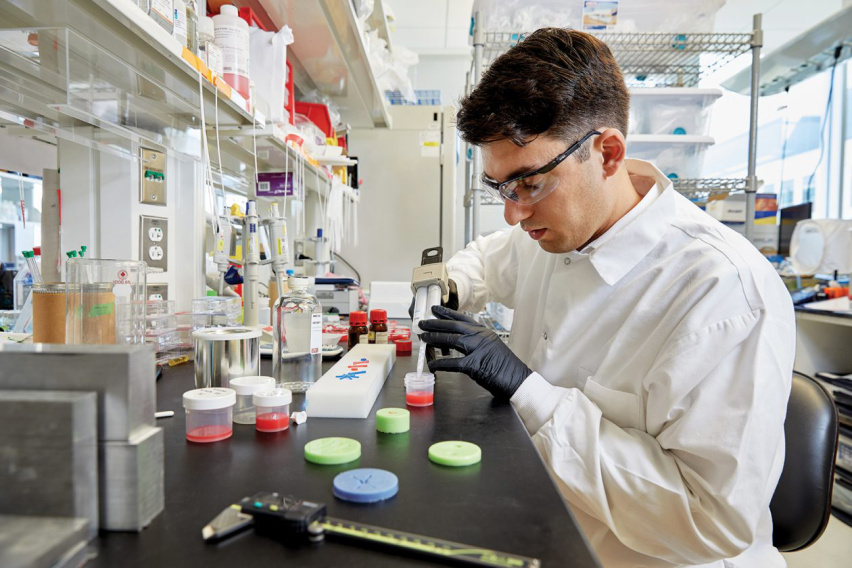
MIT Spectrum
December 13, 2019
Cancer patients undergoing targeted radiation therapy may soon benefit from technology developed at MIT to address tumor hypoxia, the diminished supply of oxygen to malignant tissue, which can pose a serious barrier to effective treatment.
Higher radiation exposure is required to kill cancerous cells in oxygen-depleted portions of a tumor, but physicians haven’t yet had a practical way of measuring oxygen levels within diseased tissue. However, MIT researchers in the laboratory of Michael Cima, a David H. Koch Professor of Engineering, are now readying a suite of implantable oxygen sensors to perform this vital task.
Gregory Ekchian MEng ’10, PhD ’18, one of Cima’s postdoctoral fellows, is responsible for bringing this technology out of the laboratory through research partially funded by a Lemelson-Vest grant and a Kavanaugh Translational Innovation Fellowship—both of which support the transfer of ideas from academia into the world beyond. “I came to MIT interested in entrepreneurship, knowing it was a critical part of the process to bring new and impactful technologies into clinical use,” Ekchian says. Under Cima’s supervision, he earned a PhD from MIT for his role in developing the oxygen sensors, and the two have since founded a company, Stratagen Bio, built around this technology.
The first clinical implementation incorporates oxygen-sensitive silicone into the tip of the kind of catheter commonly used in brachytherapy, a treatment strategy involving the temporary placement of radioactive seeds in tumors. The modified catheter, which has small holes to allow for interaction with the tumor environment, contains proprietary medical-grade silicone—a substance that absorbs oxygen from its surroundings. Once the sensor is embedded within a tumor, Cima explains, “you can determine the oxygen content of that tissue by seeing how much oxygen the silicone absorbs.” Molecular oxygen, he adds, is “paramagnetic,” meaning that the amount of oxygen in the silicone can be assessed through routine magnetic resonance imaging scans. After placing silicone-based sensors in the tumor, doctors can see how oxygen levels vary and calibrate radiation dose levels as needed throughout the course of treatment. Ekchian sought clinical partners for human trials and found willing collaborators at Boston’s Brigham and Women’s Hospital. Together, they formed a research team supported by the Bridge Project, a collaboration between MIT’s Koch Institute for Integrative Cancer Research and the Dana- Farber/Harvard Cancer Center. “People have been hoping for something like this for years,” notes Robert Cormack, a radiation oncology physicist at the Brigham and associate professor of radiation oncology at Harvard Medical School. “We’ve had other procedures for characterizing hypoxia but nothing that was clinically viable until this idea came along.”
The first clinical applications of the oxygen sensors, according to Larissa Lee—the director of gynecologic radiation oncology at the Dana-Farber/Brigham and Women’s Cancer Center and an assistant professor of radiation oncology at Harvard Medical School—will most likely be for cervical and prostate cancer patients. A large number of people could benefit from this approach; about 13,000 new cases of cervical cancer and 175,000 new cases of prostate cancer are diagnosed in the United States every year. Lee is overseeing the first clinical trial, which started this year with 10 patients who are undergoing brachytherapy for cervical cancer.
If the researchers show they can successfully measure tumor oxygen levels during the trial, a follow-up study will evaluate the use of that information to steer radiation to oxygen-deprived regions. Ekchian and other lab members are already preparing for the next round of studies. These efforts focus on enhancing the performance of the oxygen-sensing brachytherapy catheter, for which he has an award from the Koch Institute Frontier Research Program, and on deploying the silicone sensors in diverse settings that don’t involve catheters. The hope is that the sensors will ultimately prove useful in a broad range of medical applications.
This prospect is exactly what drew Ekchian to the Cima lab in the first place. “The approach here is not to make things incrementally better,” he explains. “Instead we’re focused on meeting pressing medical needs that have not been addressed before.”